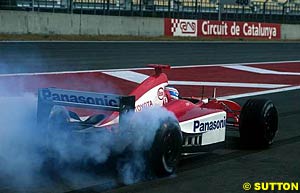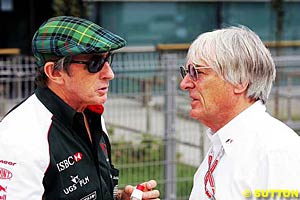Atlas F1 Magazine Writer
Fresh from the Formula One paddock
The last time a team joined Formula One, it took years of planning, and a vast haul of cash. To do so, Toyota canned their (phenomenally successful) World Rally and (moderately so) Le Mans programmes, employed the best people to complement an already capable (and huge) head count, commissioned brand new facilities and built a state-of-the-art closed-loop wind tunnel, and announced blue-chip sponsor portfolios. Then they entered a year later than scheduled, tested at 80% of Grand Prix venues in advance, then spent an entire season watching and learning from a bus parked on the periphery of most paddocks.
The purpose of this introduction is not to malign the Japanese team which are steadily moving upwards, but, rather, to illustrate just how difficult it is to break into Formula One. And, once in, an even bigger trick, as Simtek, Pacific, Prost and Arrows collectively discovered in less than a decade, is to remain in. Business, that is. Let us not forget that Toyota is a motor manufacturer, and making cars is its secondary objective – making money is its first – so building and racing Formula One cars will, the company believes, enable it to sell more cars and make even more money. That is the theory.
Many have had similar theories: over the past 55 years, 126 operations have entered Formula One; after this Sunday coming - which marks Jaguar's last race - just nine officially remain in the sport, with the futures of two more (Minardi and Jordan) seriously in doubt. In fact, not one of the operations on the British Grand Prix grid on that May day in 1950 – the inaugural race of the World Championship – is in Formula One today, and Ferrari, present only from the second race, would have folded 15 years into its life had not Fiat bailed it out.
Need more statistics? Of the 11 teams to have won the Constructors' Championship since it began in 1958, just three – Ferrari, McLaren and Williams – remain in broadly their original formats, whilst illustrious names like Vanwall, BRM, Matra, Tyrrell, Benetton, Cooper, Brabham and Lotus have gone to the wall. Equally telling is that McLaren, founded in 1966, is the second eldest present operation, (it did, though, go through enforced change of ownership in the early eighties), whilst third on the Grand Prix grid age list is Williams, which only stabilised upon their first Grand Prix win in 1980.
So, just why would any sane persons approve the expenditure of millions, or if Ferrari's three-year budgets are analysed, billions, of dollars in a business environment offering survival rates of worse than 8%, and a 70% chance of going out of business within a few years of reaching the very top of their market segment? Forget not that only 13 of those 126 entrants actually took their title, and, of those, ten are no more. Not good odds, are they?
Yet, if reports are to believed, two operations, one based in Dubai, the other in Canada, have announced their intentions of doing exactly that. They cite 350 million very powerful reasons, in countries as disparate as Afghanistan and Zambia, coming by every fortnight between March and October as justification for entry into Formula One, and, structured correctly, F1 certainly works a treat as a marketing pedestal for multi-nationals, so, perhaps there is method even if there be some madness.
Dubai has built its brand on the back of some pretty powerful campaigns, the best-known being its Team Dubai off-shore powerboat team, and so successful have been its campaigns that today the tiny city/state boasts greater year-round tourist numbers than does the entire Australian continent. The ruling family believes that F1 will add value to its campaigns, and position Dubai as a leading technological and financial centre.
Midland Group, a Toronto-based industrial conglomerate employing 50,000 people in 34 countries, has no such nationalistic ambitions. It intends using F1 to drive its expansion, particularly in the iron and steel industries. Russian emigre Alex Shnaider, who founded Midland with friend Eduard Shifrin in 1994, is primarily focused upon state-owned operations in the former Comecon region, and believes Midlands F1 will attract independent funding and pay dividends whilst acting as halo for the entire group.
With falling grid numbers and three endangered teams, any newcomer is welcome in Formula One, particularly if, like BAR, contributes substantially to the sport's fabric. But, using that team as an example, they endured years of jibes over stratospheric spending before coming good only this year. From a marketing point of view, though, BAR's lackluster performances are vindicated by owner British American Tobacco on the basis of its success in marketing an increasingly besieged product which has no alternate promotional channels, certainly not globally. In short, BAR may not have won on-track wars (yet), but they have certainly done the business for BAT.
Given the need to pour $100m per annum through their books, at least in the early stages, over and above the $48m bond, merely to create marketing pedestals, one assumes that Dubai and Midland have undertaken due diligence studies, and that these studies duly contained diligence with upper-case 'D'.
That being so, and with firm indications being that both are going their own way in terms of establishing facilities - no ease of entry for them, like BAR, which bought and stripped Tyrrell, or Renault which took over Benetton - a target of 2006 would seem a touch optimistic. Team Dubai are said to have cut a technological deal with McLaren International and hope to take over the fragmented facilities Ron Dennis' operation occupied before moving to Paragon, aka McLaren Technical Centre, and, continuing the McLaren link, it is Mercedes-Ilmor who will provide power units. It will be, to all intents and purposes, a new operation, and with a little over a year before teams unpack for Melbourne 2006, a lot of strings need pulling to make the date.
So, too, will the deadline be a tough one for Midland F1. Componentry to Midland's specifications will be supplied by the Italian constructor Dallara, which has variously provided F1 chassis to order - the last for Honda's stillborn project - and entered Formula One in its own right. No announcement regarding engines has been made, and, whilst rumours indicate that Midland may be negotiating to purchase Cosworth, they have seemingly rejected all suggestions that Jaguar Racing could provide ease of entry at lower costs. "A new team has no baggage," Shnaider said last week.
Going their own ways brings further downers for the newcomers: no television revenues for three years until, at least, the end of the Concorde Agreement, which runs out at end-2007, and, not co-incidentally, is the main stumbling block in the way for the removal of the security bond. So, go figure: there are Midland F1 and Team Dubai, pledging $48m each to procure open grid slots whilst accepting that none of the sport's considerable revenues will accrue to them for at least two years, if they actually make the grid in 2006. Why not just delay entry by those two years, use the $48m constructively from Day 1 and cut separate deals for revenues with whoever controls the sport come 2008?
If, though, marketing plans require an immediate presence in Formula One, why not purchase one of the three, possibly even four, outfits up for sale at any one time? No bond problems, no lost revenues, no advanced notice for entry, and a whole bank of data and experience – the latter two being assets no amounts of money can buy. That Midland F1 and Team Dubai have considered and rejected the purchases of Jaguar Racing (and possibly Cosworth in the case of Midland), Jordan and Minardi after diligence studies, would appear to be an indictment on the health of those entities. If that be the case, will they ever find buyers?
So, it seems, Silverstone as a Grand Prix venue is dead and buried. Certainly, that was the gist of Bernie Ecclestone's statement to The Times (of London) on Tuesday, and whilst BRDC President Jackie Stewart may be hoping for a reprieve for the first circuit to host a World Championship event, the chances of Ecclestone taking his show to the Northamptonshire venue are looking increasingly remote.
Does that mean, though, that grand prix cars will never again be seen racing in England, or that no British Grand Prix will ever again be run at Silverstone, certainly whilst Ecclestone controls the sport?
What Ecclestone, read Formula One Management, controls are the commercial rights to the FIA Formula One World Championship. He does not control Silverstone - although many allege he wished he did – and he does not control the rights to the British Grand Prix per se, only if falls within the ambit of the World Championship.
Equally, there is no rule or clause which prevents any operation from hosting a race run to existing Formula One regulations, nor is there any rule or clause which forces teams to race exclusively in the FIA Formula One World Championship. In short, following a ruling handed down by the European Union after those long and convoluted hearings in 2000, all Formula One procedures are required to comply with EU competition laws, and teams can race where and when they like, with circuits entitled to host what they like, subject only to normal safety and administrative criteria being met. And, as a sweetener, no television company can be prevented from broadcasting those races, said the EU commission.
So, a set of regulations is to hand, a circuit which patently complies with the highest standards exists, a captive audience desperate to see grand prix (note lower case) cars at Silverstone has made its feelings clear, and a promoting body, the BRDC, wishing to promote a British grand prix (and again) has made its desires frantically clear, even at £8m per race. Every team have admitted that it would be a shame to lose the race, and most sponsors suggest that Britain is vital to their businesses. BMW and Mercedes may be German, but the UK is an extremely important market, as it is for the Japanese motor companies in F1. And, the GPWC is on the side of the teams.
With the Concorde Agreement presently restricting the Formula One calendar to 17 events, and teams in a position to veto any increase over that number, Ecclestone has been forced to pay extra for additional races, with the actual figure said to be in the vicinity of £250,000 per team.
Standard race agreements see the promoters paying Ecclestone a fee and doing all the work whilst signing over all rights other than gate income to his companies. He then pays teams according to set scales, and keeps the balance after expenses. TV companies, too, pay his companies. So, in short, promoters do all the work, and Ecclestone keeps all the revenues after agreed payments. And, his status amongst Britain's fifth richest proves there are no losses.
So, the BRDC can promote a British grand prix as long as it does not use the term 'Formula One' or its derivatives, and run a race to present grand prix regulations. It has the facilities, and has done all the work in the past, in any event. It may not be able to charge F1 ticket prices, but, then, it won't have to shell out £8m in the first place: here is wagering six or seven teams will agree to a race at Silverstone for no more than the figure presently paid them for an 18th race – without anywhere near those travel expenses. And, if they need run a third car for 50% more to make an 18-car grids, the lot can be bought for under £2m. How much more would it need to persuade Ferrari and one more? It would not quite be a return to the pre-FOCA days, when every team did a separate deal with circuit owners, but it would not be far off, either.
Circuit hoardings and VIP enclosure revenues, too, would go the way of Silverstone, and, finally, the BRDC would be entitled to sell television rights to the highest bidder, and, you can bet, the BBC would love to get one over ITV, so bidding would be fiercer then fierce. Forget not that both have broadcast the event in the past, so won't be starting from scratch.
Of course, nothing beats a real World Championship Grand Prix - with one hosted by Silverstone right up there with the very best – but it does show that the BRDC and British public do have alternatives – even if written in lower case.

 Then, in their debut season, 2002, they scored just two points; in their second 16...
Then, in their debut season, 2002, they scored just two points; in their second 16...

 Not necessarily; there is an alternative...
Not necessarily; there is an alternative...
|
Contact the Author Contact the Editor |
Please Contact Us for permission to republish this or any other material from Atlas F1.
|
Volume 10, Issue 42
Atlas F1 Exclusive
Interview with David Coulthard
Interview with Robert Doornbos
2004 Brazilian GP Preview
2004 Brazilian GP Preview
Brazilian GP Facts & Stats
Columns
The F1 Trivia Quiz
Bookworm Critique
On the Road
Elsewhere in Racing
The Weekly Grapevine
> Homepage |
